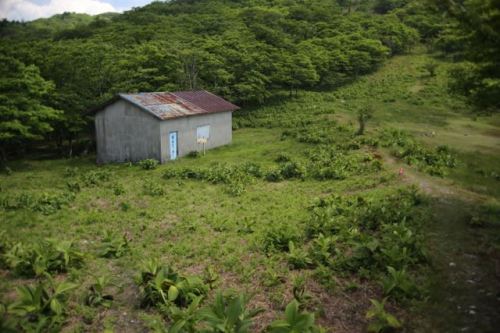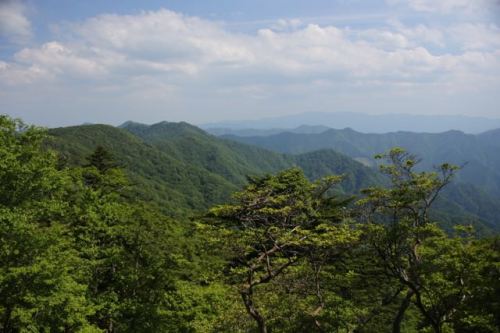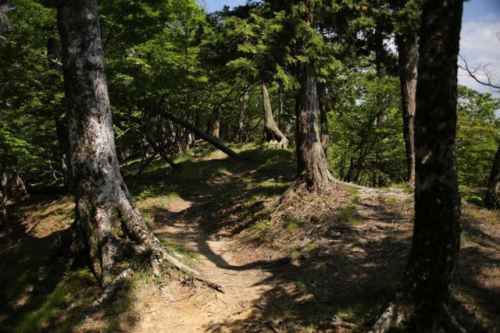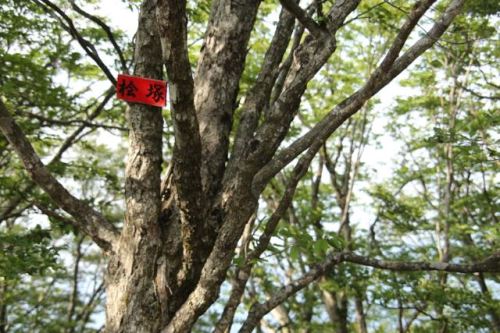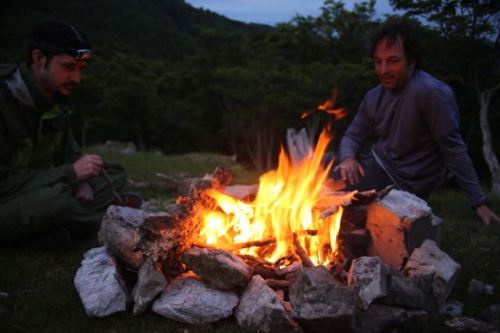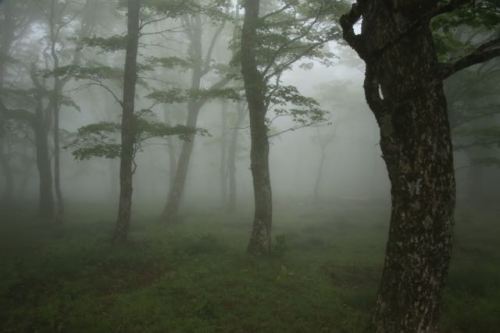On my last visit, I vowed to never return, but something kept drawing me back. Like a page in a diary you’re not supposed to read, I just had to find some kind of redeeming quality to a plateau scarred by the scalpel of development. Would Fukada himself be spinning in his grave to see what has become of his beloved mountain? Perhaps not, as his ‘famous’ book refers to the “toll road” that “had been built into the heart of the mountain.” Could this be the Odaigahara Skyline, which now runs to within spitting distance of the high point?
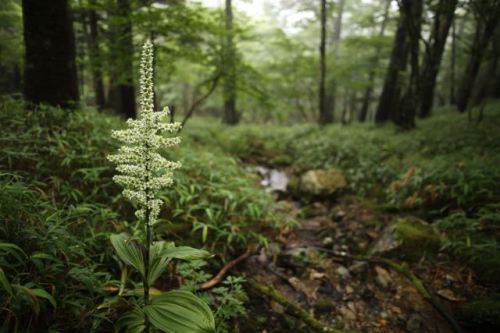
On the long, winding drive up the skyline, the bus vanished into a thick wall of cloud that frequently lingers around the plateau. Clear days are hard to come by, and even the beautiful sunshine and crystal clear skies of Osaka could not penetrate the fog fortress. I disembarked into this blanket of mist and immediately retreated into the souvenir shop/restaurant to use the facilities. I also inquired about the closing time of the noodle shop, as I’d planned to grab a bowl before boarding the final bus at 3:30. I had roughly five hours to spend in my search for that spark.

The long-familiar trail to the high point starts in front of the visitor’s center and is in incredibly good shape despite the heavy foot traffic. On this cool, misty July morning, I was pleasantly surprised at the lack of crowds, as my other two experiences came later in the season, when flocks of camera wielding tourists line the paths in search of that perfect autumn leaf. I passed just one trio hikers before reaching the main junction below the peak of Hide-ga-take. A lookout platform had recently been built here, as a way of keeping the actual summit from getting overloaded with hikers. Signposts teased visitors about the splendid views of Mt. Fuji from this vantage point, but in the dense fog I could do little else than use my imagination.

The summit was teeming with hikers, including a rowdy group from Mie Prefecture who were well into an altered state of inebriety, with the leader chain-smoking away like he was at his neighborhood izakaya. In the short interval between drags I moved in to have a friendly chat, and was rewarded with homemade inari sushi as well as the famed Yoshino delicacy of sushi wrapped in persimmon leaves. As we chatted, the sky lightened up and the cloud dropped, revealing a sea of cumulus stretching out to eternity. I climbed to the second story of the concrete resthouse to take in the views. Unfortunately, the Omine mountains were still hiding in their own bank of menacing cloud, but it was a much better alternative than fighting off the strong winds and horizontal rains. A quartet of deer sat just off the lee slope of the narrow summit, grazing with an air of accepted indifference.
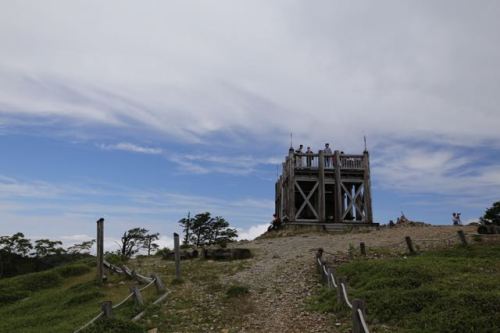
I retraced my steps back to the junction and continued traversing south towards Daijyakura cliffs on the far end of the plateau. The cloud stayed low, affording vistas back towards Mt. Hide’s knuckle perch. A series of wooden steps have been built across much of the plateau, and the unexpected sunshine had begun to dry things out a bit. These wooden walkways are slicker than ice rinks when covered with a layer of water, but on the dry promenade I could focus on the scenery more than my footfalls.

And what scenery it was. An endless carpet of bamboo grass stretching out beneath the boardwalks, with needle-like stalks of dead trees poking out at irregular intervals. Apparently this used to be a healthy forest until a very strong typhoon swept through and knocked all of the trees off their foundations. The toppled trees allowed more sunlight to penetrate the forest floor, which dried out the moss and allowed the bamboo grass to thrive. The grass, in turn, attracted the deer, who ate the bark off the trees and helped to destroy the remaining forest.

I pushed on, ignoring the junction loop trail back to the parking lot and continued towards the cliffs. Dropping out of the sunlight and back into the fog belt triggered a sudden change inside of me. For here the true magic of the place presented itself, in a stunning reminder of the necessity of condensation on the delicate ecosystem. The beech trees looked happier and full of life, as this section of moss-laden woods lay sheltered from the strong winds that often push through the massif.

The wildlife seemed to welcome the change as well, as a badger crossed the trail just in front of me and foraged through the grass in search of an early afternoon meal.

Soon I reached another flatland, with a giant statue of emperor Jimmu standing guard. Fukada mentions this statue in his book, but how in the world did they get that thing up here? It must’ve been erected around the same time that the skyline was complete, which leads me to believe that Fukada did actually visit when the road did run all the way up the plateau, though in his time I sure it was a simple dirt track and not the meandering asphalt serpent of today.

I reached the junction for the cliff lookout point and dropped down for a look, or at least a glimpse of what the area looked like. The cloud still had a tight grip around the towering beech trees lining the narrow path. It took about 10 minutes to reach the observation point, lined by a chain railing to keep the tourists from tumbling down into the void. Apparently it’s a vertigo-inducing spectacle in clear weather, but with nothing to see I felt safe walking all the way to the edge to peer down into the white void.

I sat for a while and waited for the clouds to lift, but the wait was in vain. Rather than feeling dejected, I silently relished in hidden delight, for this gave me an excuse to come back in the future.

Back at the junction, the route passed through a tunnel of rhododendron bushes before losing close to 200 meters of vertical altitude until reaching a clear brook. A suspension bridge offers safe passage for visitors, and once across the stream the long climb back to the parking lot commences. Signs on my left warned that the trails of Nishi Odai-ga-hara are off-limits to those without special permission to enter. It seems as if the higher ups are finally starting to care about conservation.

I reached the parking lot around 3pm and had a quick bowl of noodles before boarding the bus. Maybe it was the humidity, or just the weather, but the crowds were much more manageable and dare I say pleasant on this third trip to the plateau. Perhaps the green season is indeed the best time to experience the magic of Odai-ga-hara. It may be too early to tell, but I’m really starting to warm up to the place. I think a future trip to Nishi Odai-ga-hara may just seal the deal.
Reference
One Hundred Mountains of Japan by Kyūya Fukada, translated by Martin Hood, University of Hawaii Press, 2015. More information about Fukada’s mountains can be found here, and the translation can be purchased here.






